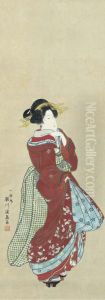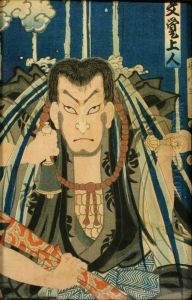Utagawa Kunitomi Paintings
Utagawa Kunitomi was a Japanese ukiyo-e artist who lived during the late Edo period. He was born in 1779 in Japan and passed away in 1839. Kunitomi was a member of the renowned Utagawa school, which was one of the most significant and influential groups of artists in the history of Japanese woodblock prints, also known as ukiyo-e. The Utagawa school was founded by Utagawa Toyoharu and later led by Utagawa Toyokuni I, under whom Kunitomi presumably studied, although specific details about his apprenticeship are not well-documented.
During his career, Utagawa Kunitomi produced a variety of woodblock prints, including bijinga (pictures of beautiful women), yakusha-e (actor prints), and sumo-e (sumo wrestling prints). His works are characterized by the use of vibrant colors and a keen eye for detail, which were hallmarks of the Utagawa school style. Kunitomi's prints were a part of the popular culture of the time, serving both as entertainment and as an artistic representation of the 'floating world'—the pleasure-seeking urban lifestyle of Edo-period Japan.
Despite his contributions, Kunitomi is not as well-known as some of his contemporaries, such as Utagawa Hiroshige or Utagawa Kuniyoshi, and information about his life and the full extent of his works is relatively scarce. His prints may be found in various museum collections that specialize in Asian art and ukiyo-e. Kunitomi's artistry is a testament to the rich tradition of the Utagawa school and its role in the development of Japanese woodblock printing. His legacy, like many artists of the period, provides insight into the cultural and artistic practices of Edo Japan.


